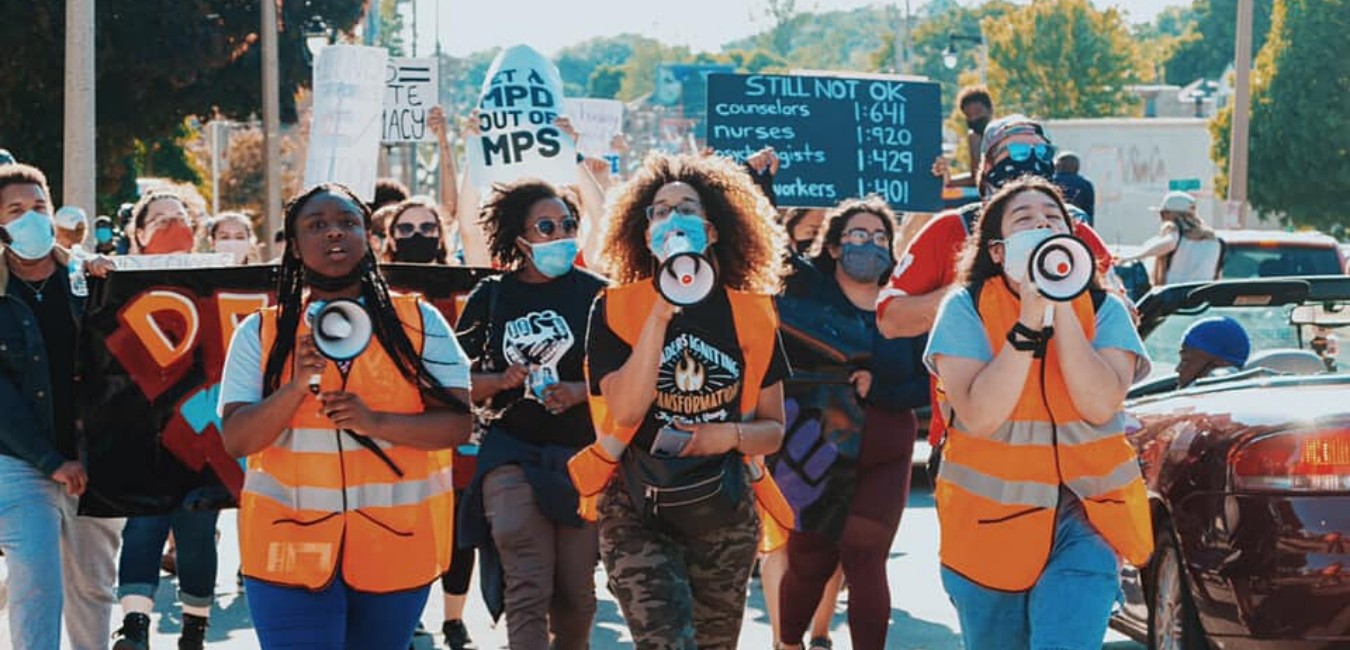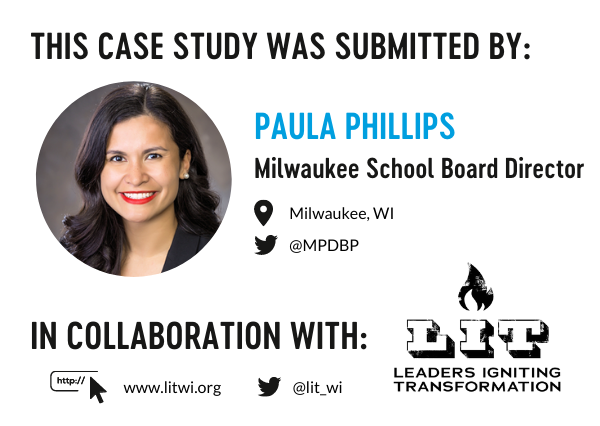Youth Power Agenda
Milwaukee Public Schools, WI
Student Population: 75,000 | Government type: School district | Topic: Defunding School Resource Officers (SROS)
The Program
Milwaukee Public Schools is the largest and most diverse public school district in Wisconsin. Milwaukee is also one of the most unequal municipalities in the United States. Years of increasingly harsh law enforcement and punitive school policies have resulted in growing concern within affected communities, particularly among Black and Brown students who have been disproportionately impacted by the presence of police officers and safety assistants in and around their schools.
In 2016, Milwaukee Public Schools began responding to these concerns and ended the practice of permanently assigning School Resource Officers (SROs) to schools. They followed this up with a school board evaluation of the SRO program. This report did not produce any quantifiable data demonstrating that SRO presence in schools diverted students from the justice system, per the program’s purported intent.
Following the organizing and advocacy of Black and Brown young people, in 2019, the board reduced the contracts the district had established with the Milwaukee Police Department and voted down a proposed contract for upgraded X-ray metal detectors.
The murder of George Floyd by the Minneapolis police department inspired a national moment of reckoning in the summer of 2020. Youth organizers in Milwaukee took part in this moment by building on their years of advocacy with a newfound level of community support, demanding that the school board fully end the practice of policing in schools. In 2020, the board unanimously voted to end all police contracts and limited surveillance equipment purchases to the extent permitted under state law.
The key provisions of the 2020 ordinance include:
Immediate termination of all contracts with the Milwaukee Police Department for the services of SROs and other personnel
Termination of any further negotiations with the Milwaukee Police Department for the services of SROs and other personnel
Termination of any contracts to buy or maintain criminalizing equipment including metal detectors, facial recognition software, and social media monitoring software
A direction that the school administration creates a plan for how to use the funds previously allocated for police contracts. This plan should be done in cooperation with the advisory council established by the Black Lives Matter Resolution, the MPS Restorative Practices team, Milwaukee's Office of Violence Prevention, community partners such as the Running Rebels Violence Free Zone teams, and any other community-based organizations who may provide valuable input into the process
A direction for the school board’s Governmental Relations Services to lobby the Wisconsin Legislature and the Governor to repeal a law that forces Milwaukee schools to employ truancy officers, which the board strongly opposed
Collaborative Governance
Impacted communities played the central role in fighting to defund police in schools, and in shaping the alternative vision. Leaders Igniting Transformation (LIT), supported by the Black Educators Caucus and Milwaukee Inner-city Congregations Allied for Hope (MICAH) led the fight in Milwaukee Public Schools (MPS) and spent years fighting for these changes. LIT was founded in 2017 by young Black and Brown people directly impacted by policies that harm their communities. LIT builds homegrown leadership, and through these young leaders, transforms their communities. Through robust civic engagement and resiliency-building efforts, LIT’s model empowers young Black and Brown people to drive the fight for social justice.
From the beginning, youth leaders at LIT took the lead as primary advocates with a clear vision for a safe and supportive learning environment as outlined in their youth agenda. The very first demand of this agenda, published in 2018, is the removal of police from schools. These youth leaders took a multi-faceted approach, including broad community education and a political strategy. They identified potential supporters on the school board and engaged in an extended campaign to educate and move more board members to align with their vision of safety in schools, even as board members assessed a range of funding priorities with limited resources. In 2019, five new school board members were elected. All of these newly elected members had pledged support to LIT's youth power agenda during their candidacy. Once on the school board, these school board members voted against metal detectors and to increase resources for mental health.
During the 2020 defunding campaign, the young leaders’ vision was met with significant push back. Some community members and parents were concerned that such changes were simply a “gut reaction,” while some felt the alternatives for funding were not fully developed. Others expressed fear that schools would get “out of control” and the board would get the blame.
Youth leaders effectively communicated their experiences and helped educate the community about the realities of how police in schools harm students, particularly youth of color. Youth leaders consistently showed up to testify at school board hearings, offering compelling stories about what they needed and the vision they had for their learning community. These students—many members of LIT—experienced a discriminatory environment that felt more like prison than a thriving learning environment. Student stories grounded the narrative and painted the vivid picture of day-to-day experiences. Students described going through metal detectors, being disrespected and looked down on by authority figures, and how they were impacted by resource allocation that prioritized punitive infrastructure over supportive investments in services and counselors. The students also shared their proactive vision for thriving schools that invest in restorative practices, culturally relevant curricula, mental health resources, smaller classroom sizes, and more. The board direction also establishes a practice for ongoing collaboration, power-sharing, and accountability, particularly in the 2020 ordinance as noted above.
Emphasis on equity
In the 2018-19 school year, MPS had 74,633 students, 89.9% (approximately 67,095) of which were students of color. In 2018, the US Department of Education Office of Civil Rights entered into a Resolution Agreement with Milwaukee Public Schools after a multi-year investigation into whether the district discriminated against Black students. Federal investigators found that Black students were overrepresented in the proportion of students who were referred to law enforcement (in addition to several other data points that indicated discrimination). [1] The most recent local report fails to provide data on referrals to law enforcement, but federal data from the 2015-16 school year shows another 30-point disparity between Black student enrollment and the percentage of students referred to law enforcement. [2] Research shows that police interact with Black students at disproportionately high rates.
There is no substantial evidentiary support for the proposition that suspensions or police presence in schools create safer learning environments. [3] To the contrary, studies have shown that schools are no safer, even after years of punitive policing and disciplinary measures, than before such policies are implemented.[4] Policing is not only ineffective, it also hurts individual students’ academic performance. One study found that experiencing an arrest for the first time in high school nearly doubles the odds of a student dropping out, and a court appearance nearly quadruples these odds. [5] In addition to academic harms, recent research shows that over time, the mere presence of police may have a compounding psychological effect on students’ “nervous and immune systems that may result in anxiety, restlessness, lack of motivation, inability to focus, [and] social withdrawal.” [6]
Often, school boards approach budgeting with an annual budget cycle mindset. It is imperative for budgeting to align with public will, coupled with student priorities, to drive a longer-term vision over a number of years. Budgets often perpetuate white supremacy by funding punitive systems that use fear as a way to control students rather than systems of support. A reimagined anti-racist education includes partnering with the community to provide holistic care to students, invest in mental health supports, and focus on restorative practices that help young people grow and thrive.
Analysis
Preemption: State laws may require a certain level or type of law enforcement presence in school districts or require that police are called for certain types of incidents.
Local government dynamics: Some board members took longer than others to come around to alternative visions of safety in school. Over time, the school board responded to ongoing student advocacy and education, taking gradual steps to reduce punitive infrastructure in the school district. The 2020 vote to end SRO contracts was unanimous.
Policy: The growth of this work from 2016, led by visionary and committed students is hardly complete. While divestment is an important first step, reinvestment decisions and implementation are critical for students to thrive and those decisions are yet to come.
References
Resolution Letter for Case No. 05-14-5003, U.S. Department of Education, Office for Civil Rights, January 31, 2018, https://www2.ed.gov/about/offices/list/ocr/ docs/investigations/more/05145003-a.pdf
Office of Civil Rights, U.S. Department of Education, “Milwaukee School District: Discipline Report” (2015), https://ocrdata.ed.gov/Page?t=d&eid=29660&syk=8&pid=2539&sr=1&Report=6
NATIONAL ASSOCIATION OF SCHOOL PSYCHOLOGISTS, RESEARCH ON SCHOOL SECURITY: THE IMPACT OF SECURITY MEASURES ON STUDENTS (2013), citing several studies (on file with Center for Popular Democracy).
Nance, “Dismantling the School-to-Prison Pipeline: Tools for Change,” citing Advancement Project and Harvard Univ. Civil Rights Project, “Opportunities Suspended” (stating that after four years of implementation, schools that used zero tolerance policies were less safe than those that did not use them).
Gary Sweeten, “Who Will Graduate? Disruption of High School Education by Arrest and Court Involvement” Justice Quarterly 23, issue 4 (2006).
Mbekeani-Wiley, “Handcuffs in Hallways.” See also Rhea W. Boyd, Angela M. Ellison, and Ivor B. Horn, “Police, Equity, and Child Health,” Pediatrics 137, no. 3 (2016), http://pediatrics.aappublications.org/content/early/2016/01/28/peds.2015-2711.
Last updated: January 21, 2021
If you’re interested in learning more, please contact info@localprogress.org













